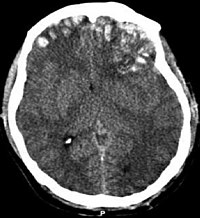
Photo from wikipedia
Treatment of cardiac arrest/cardiopulmonary resuscitation (CA/CPR)-induced brain injury remains a challenging issue without viable therapeutic options. Octanoic acid (OA), a lipid oil that is mainly metabolized in the astrocytes of… Click to show full abstract
Treatment of cardiac arrest/cardiopulmonary resuscitation (CA/CPR)-induced brain injury remains a challenging issue without viable therapeutic options. Octanoic acid (OA), a lipid oil that is mainly metabolized in the astrocytes of the brain, is a promising treatment for this type of injury owing to its potential functions against oxidative stress, apoptosis, inflammation, and ability to stabilize mitochondria. However, the application of OA is strictly limited by its short half-life and low available concentration in the target organ. Herein, based on our previous research, an OA-based nanotherapy coated with a neutrophil membrane highly expressing RVG29, RVG29-H-NPOA, was successfully constructed by computer simulation-guided supramolecular assembly of polyethylenimine and OA. The in vitro and in vivo experiments showed that RVG29-H-NPOA could target and be distributed in the injured brain focus via the relay-targeted delivery mediated by RVG29-induced blood-brain barrier (BBB) penetration and neutrophil membrane protein-induced BBB binding and injury targeting. This results in enhancements of the antioxidant, antiapoptotic, mitochondrial stability-promoting and anti-inflammatory effects of OA and exhibited systematic alleviation of astrocyte injury, neuronal damage, and inflammatory response in the brain. Due to their systematic intervention in multiple pathological processes, RVG29-H-NPOA significantly increased the 24 h survival rate of CA/CPR model rats from 40% to 100% and significantly improved their neurological functions. Thus, RVG29-H-NPOA are expected to be a promising therapeutic for the treatment of CA/CPR-induced brain injury.
Journal Title: ACS nano
Year Published: 2023
Link to full text (if available)
Share on Social Media: Sign Up to like & get
recommendations!